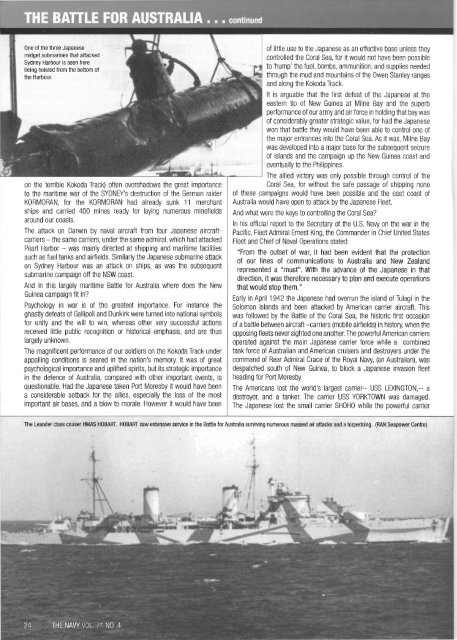VOL 71 No4 - Navy League of Australia
VOL 71 No4 - Navy League of Australia
VOL 71 No4 - Navy League of Australia
You also want an ePaper? Increase the reach of your titles
YUMPU automatically turns print PDFs into web optimized ePapers that Google loves.
One <strong>of</strong> the three Japanese<br />
midget submarines that attacked<br />
Sydney Harbour is seen here<br />
being hoisted from the bottom <strong>of</strong><br />
the Harbour.<br />
on the terrible Kokoda Track) <strong>of</strong>ten overshadows the great importance<br />
to the maritime war <strong>of</strong> the SYDNEY's destruction <strong>of</strong> the German raider<br />
KORMORAN, for the KORMORAN had already sunk 11 merchant<br />
ships and carried 400 mines ready for laying numerous minefields<br />
around our coasts.<br />
The attack on Darwin by naval aircraft from four Japanese aircraftcarriers-<br />
the same carriers, under the same admiral, which had attacked<br />
Pearl Harbor - was mainly directed at shipping and maritime facilities<br />
such as fuel tanks and airfields. Similarly the Japanese submarine attack<br />
on Sydney Harbour was an attack on ships, as was the subsequent<br />
submarine campaign <strong>of</strong>f the NSW coast.<br />
And in this largely maritime Battle for <strong>Australia</strong> where does the New<br />
Guinea campaign fit in?<br />
Psychology in war is <strong>of</strong> the greatest importance. For instance the<br />
ghastly defeats <strong>of</strong> Gallipoli and Dunkirk were turned into national symbols<br />
for unity and the will to win, whereas other very successful actions<br />
received little public recognition or historical emphasis, and are thus<br />
largely unknown.<br />
The magnificent performance <strong>of</strong> our soldiers on the Kokoda Track under<br />
appalling conditions is seared in the nation 's memory. It was <strong>of</strong> great<br />
psychological importance and uplifted spirits, but its strateg ic importance<br />
in the defence <strong>of</strong> <strong>Australia</strong>, compared with other important events, is<br />
questionable. Had the Japanese taken Port Moresby it would have been<br />
a considerable setback for the allies, especially the loss <strong>of</strong> the most<br />
important air bases, and a blow to morale. However it would have been<br />
<strong>of</strong> little use to the Japanese as an effective base unless they<br />
controlled the Coral Sea, for it would not have been possible<br />
to 'hump' the fuel, bombs, ammunition, and supplies needed<br />
through the mud and mountains <strong>of</strong> the Owen Stanley ranges<br />
and along the Kokoda Track.<br />
It is arguable that the first defeat <strong>of</strong> the Japanese at the<br />
eastern tip <strong>of</strong> New Guinea at Milne Bay and the superb<br />
performance <strong>of</strong> our army and air force in holding that bay was<br />
<strong>of</strong> c;onsiderably greater strategic value, for had the Japanese<br />
won that battle they would have been able to control one <strong>of</strong><br />
the major entrances into the Coral Sea. As it was, Milne Bay<br />
was developed into a major base for the subsequent seizure<br />
<strong>of</strong> islands and the campaign up the New Guinea coast and<br />
eventually to the Philippines.<br />
The allied victory was only possible through control <strong>of</strong> the<br />
Coral Sea, for without the safe passage <strong>of</strong> shipping none<br />
<strong>of</strong> these campaigns would have been possible and the east coast <strong>of</strong><br />
<strong>Australia</strong> would have open to attack by the Japanese Fleet.<br />
And what were the keys to controlling the Coral Sea?<br />
In his <strong>of</strong>ficial report to the Secretary <strong>of</strong> the U.S. <strong>Navy</strong> on the war in the<br />
Pacific, Fleet Admiral Ernest King, the Commander in Chief United States<br />
Fleet and Chief <strong>of</strong> Naval Operations stated:<br />
"From the outset <strong>of</strong> war, it had been evident that the protection<br />
<strong>of</strong> our lines <strong>of</strong> communications to <strong>Australia</strong> and New Zealand<br />
represented a "must". With the advance <strong>of</strong> the Japanese in that<br />
direction, it was therefore necessary to plan and execute operations<br />
that would stop them."<br />
Early in April 1942 the Japanese had overrun the island <strong>of</strong> Tulagi in the<br />
Solomon Islands and been attacked by American carrier aircraft. This<br />
was followed by the Battle <strong>of</strong> the Coral Sea, the historic first occasion<br />
<strong>of</strong> a battle between aircraft -carriers (mobi le airfields) in history, when the<br />
opposing fleets never sighted one another. The powerful American carriers<br />
operated against the main Japanese carrier force while a combined<br />
task force <strong>of</strong> <strong>Australia</strong>n and American cruisers and destroyers under the<br />
command <strong>of</strong> Rear Admiral Crace <strong>of</strong> the Royal <strong>Navy</strong>, (an <strong>Australia</strong>n), was<br />
despatched south <strong>of</strong> New Guinea, to block a Japanese invasion fleet<br />
heading for Port Moresby.<br />
The Americans lost the world 's largest carrier-- USS LEXINGTON,-- a<br />
destroyer, and a tanker. The carrier USS YORKTOWN was damaged.<br />
The Japanese lost the small carrier SHOHO while the powerful carrier<br />
The Leander class cruiser HMAS HOBART. HOBART saw extensive service in the Battle for <strong>Australia</strong> surviving numerous massed air attacks and a torpedoing. (RAN Seapower Centre)

















